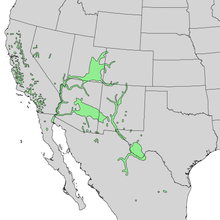Populus fremontii
| Populus fremontii | |
|---|---|
 |
|
| Fremont Cottonwood at Zion Lodge, Zion National Park, Utah | |
| Scientific classification | |
| Kingdom: | Plantae |
| (unranked): | Angiosperms |
| (unranked): | Eudicots |
| (unranked): | Rosids |
| Order: | Malpighiales |
| Family: | Salicaceae |
| Genus: | Populus |
| Section: | Aigeiros |
| Species: | P. fremontii |
| Binomial name | |
|
Populus fremontii S. Watson |
|
 |
|
| Natural range of P. fremontii | |
Populus fremontii, commonly known as Fremont's cottonwood or the Alamo cottonwood, is a cottonwood (and thus a poplar) native to riparian zones of the Southwestern United States and northern through central Mexico. It is one of three species in Populus sect. Aigeiros.
The tree is native to the Southwestern United States and Mexico. In the United States, the species can be found in California, Nevada, Utah, Arizona, New Mexico, Texas, and Colorado. In Mexico, it can be found in Baja California, Baja California Sur, Sonora , Chihuahua, Coahuila, Nuevo León, Mexico State, and Puebla.
The riparian tree grows near streams, rivers, springs, seeps, wetlands, and well-watered alluvial bottomlands at elevations below 2,000 m (6,600 ft) elevation.
P. fremontii is a large tree growing from 12–35 m (39–115 ft) in height with a wide crown, with a trunk up to 1.5 m (4.9 ft) in diameter. The bark is smooth when young, becoming deeply fissured with whitish cracked bark on old trees.
The 3–7 cm (1.2–2.8 in) long leaves, are cordate (heart-shaped) with an elongate tip, with white veins and coarse crenate teeth along the sides, glabrous to hairy, and often stained with milky resin. Autumn colors occur from October–November, mainly a bright yellow, also orange, rarely red.
...
Wikipedia
